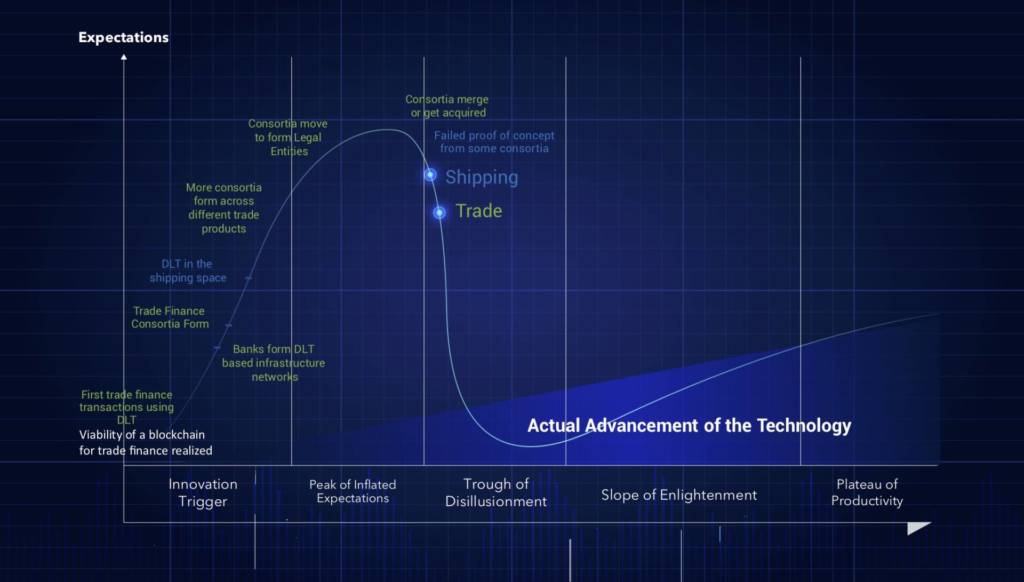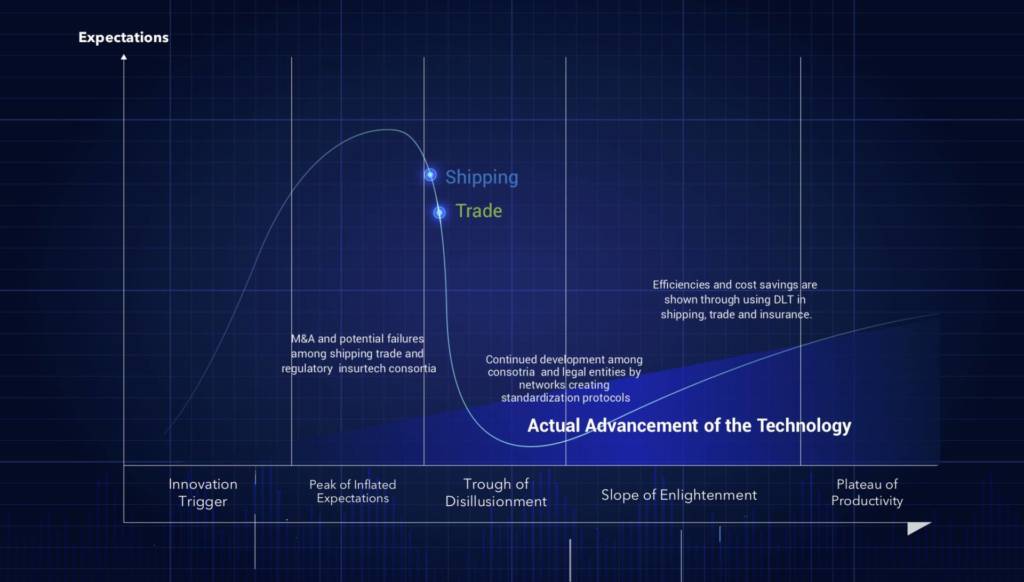The Gartner hype cycle serves as a tool to help decision makers and investors gauge the actual current state of a technology in a given domain, separating its real-world utility from its surrounding hype and disillusionment. The cycle was first introduced in 1995 and has since served as an accurate representation of the typical progression of an emerging technology.
There are two fundamental lessons that can be garnered from the hype cycle. Firstly, enterprises should not invest in technologies just because they are being hyped. Secondly, enterprises must be wary to discredit technologies simply because they are not living up to this early over expectation. Visually seeing where a technology for a given domain lies on the hype cycle curve, allows decision makers to quickly determine if the technology is currently experiencing overhype or disillusionment. Leveraging this knowledge will help in making sensible business decisions. Our notion of where DLT in the trade and shipping domains lie, is shown in the next diagram.
Trade
Based on a detailed analysis of market events on the DLT space for trade, we have determined that today, trade has reached the far side of the peak of inflated expectations, looming just ahead of the trough of disillusionment. Our analysis predicts that DLT in the trade space will reach the plateau of productivity in 5-10 years.
Shipping
The development of DLT in the shipping space came shortly after DLT in the trade space, and has followed a similar pattern of events ever since. Based on this we have determined that shipping today also lies just beyond the peak but still sits slightly behind the trade domain. Similar to trade, DLT in the shipping space is expected to reach the plateau of productivity in 5-10 years.
In the subsequent sections we will justify why we have identified these points, highlight what key milestones may lie ahead, and identify some fundamental advancements that need to be made to facilitate the push to mass adoption.
How did we get to where we are?

For DLT as related to both the trade and shipping domains, the technological trigger occurred in the years following the inception of blockchain in 2009. These years were ripe with talks surrounding use cases for the technology, with no products yet to exist.
With respect to trade, hype started to grow in September 2016 when Barclays and Wave completed the world’s first blockchain transaction. This milestone breakthrough was closely followed by JP Morgan forming an interbank information network using the Quorum infrastructure in October of the same year. The following year saw the formation of the we.trade and Marco Polo consortia in January and September respectively.
The shipping-specific DLT domain gained hype in a similar fashion a few months after the trade domain. TradeLens and CargoX were both launched in January 2018, with Voltron following in June with their first successful transaction. Each of these highly-specialized first generational products, with limited practical use are highly representative of the rising hype phase of the hype cycle.
At the peak of inflated expectations, the number of providers grows and many of the enterprises begin to alter their business strategies for the technology. Vakt and Komgo formed in August of 2018, and many of the other consortia formed earlier began the process of themselves becoming legal entities around this time. Near the end of the peak, acquisitions and failures begin to occur. Batavia merges with we.trade in October 2018 and reports emerge that the TradeLens network is struggling to gain traction.
What is coming?

Following the Hype cycle model, there are some deceptively dark times over the horizon for DLT in the trade and shipping spaces. Early stage trials, successful on a small scale, may struggle when bringing the technology to a larger scale. These necessary minor shortcomings will be disproportionately cited in the media, rapidly discrediting the technology and bringing the hype to the depths of the trough of disillusionment. On the way down more failures and further consolidations may occur while developers work with early stage feedback to create enhanced versions of the technology. During this decline, later-stage investors may be interested in providing funding, capitalizing on the relatively inexpensive equity available following the hype micro-bubble bursting.
While all this media downturn is occurring on the surface, developers and designers will continue to toil away at improving the technology. Over time, the merit of the technology itself, and it’s real ability to hold a positive impact on the industry will gradually be realized, pulling it up the slope of enlightenment. After gathering traction as an enterprise solution for shipping and trade, media hype surrounding DLT in these industries will come to an end, bringing with it an end to the hype cycle.






























